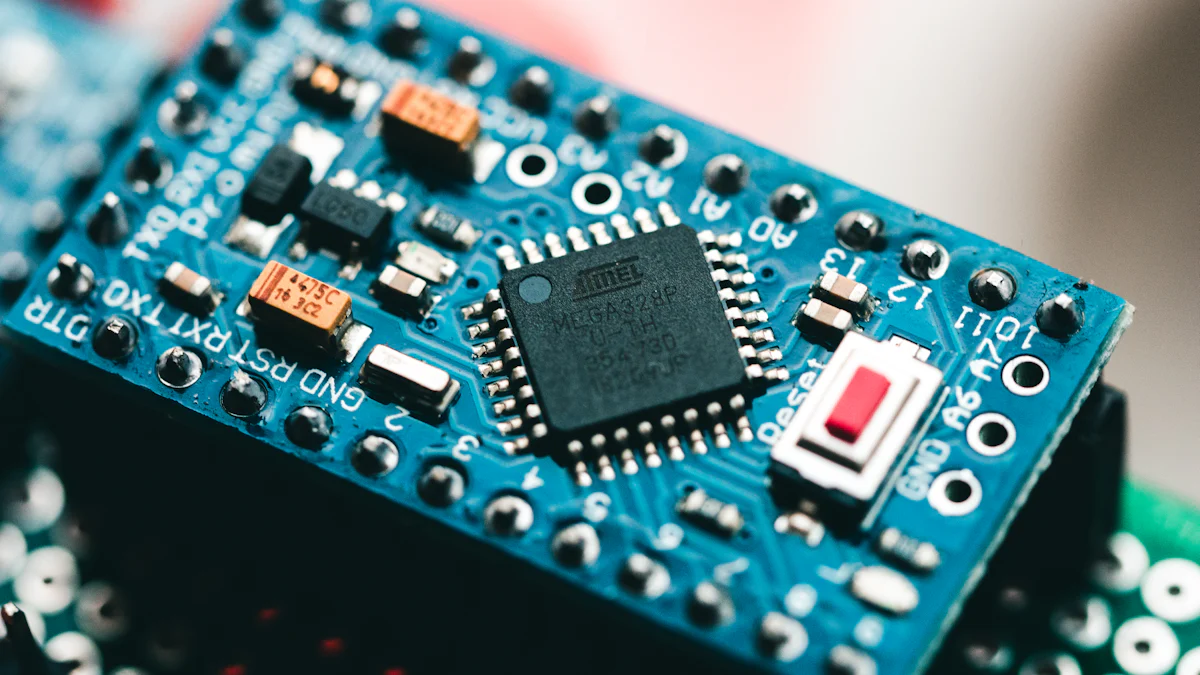TG140 PCB vs TG150 and TG180: Which Is Best?

Printed Circuit Boards (PCBs) serve as the backbone of modern electronics, providing essential pathways for electrical signals. The term "TG" refers to the glass transition temperature, a critical factor in PCB performance. Higher TG values indicate better thermal stability, crucial for various applications. The global PCB market continues to grow, driven by advancements in manufacturing technologies. This blog aims to compare TG140 PCB, TG150, and TG180 PCBs, helping readers understand their differences and choose the best option for specific needs.
Understanding TG in PCBs
Definition of TG
The glass transition temperature, often abbreviated as TG, is a pivotal parameter in the realm of printed circuit boards (PCBs). Research on Glass Transition Temperature (Tg) of PCB Materials highlights that TG represents the temperature at which a PCB material transitions from a rigid state to a more flexible one. This transformation impacts both the mechanical and electrical properties of the board. A higher TG value signifies enhanced temperature resistance, particularly vital in lead-free processes.
Importance of glass transition temperature
The significance of TG extends beyond mere temperature thresholds. It serves as an indicator of the board's ability to withstand thermal stress without compromising its structural integrity. Exceeding the TG can lead to softening and deformation, which may adversely affect the board's performance. Temperature Profiles and Glass Transition Temperature (Tg) in PCB Materials underscores the importance of maintaining the TG within specified limits to ensure reliable operation. The TG value directly influences the durability and longevity of PCBs in various applications.
How TG affects PCB performance
TG plays a crucial role in determining the performance and reliability of PCBs. Impact of PCB Glass Transition Temperature (Tg) on Mechanical Stability reveals that surpassing the TG can alter the physical properties of the board, affecting its mechanical stability. The TG value dictates the temperature range for optimal operation. A PCB with a higher TG can endure higher soldering temperatures without delamination or warpage, enhancing long-term reliability. The choice of TG directly impacts the board's suitability for specific applications, especially those involving high-temperature environments.
Factors influencing TG selection
Selecting the appropriate TG for a PCB involves considering several factors. These factors ensure that the board meets the specific requirements of its intended application.
Application requirements
The intended use of the PCB significantly influences the choice of TG. Detailed Comparison of TG 150 PCB, TG 180 PCB, and TG 140 PCB emphasizes that different applications demand varying levels of thermal performance. Consumer electronics and low-power devices may suffice with a lower TG, such as TG140. In contrast, industrial electronics and high-performance devices necessitate higher TG values like TG150 or TG180. The TG selection must align with the thermal demands and operational conditions of the application.
Environmental conditions
Environmental factors also play a pivotal role in TG selection. Significance of PCB Glass Transition Temperature (Tg) in High Heating Environments points out that PCBs operating in high-temperature or moisture-rich environments require higher TG values. A higher TG ensures better temperature resistance and stability, preventing potential issues like delamination or warpage. The environmental conditions dictate the need for a PCB that can maintain its integrity and functionality under varying thermal stresses.
TG140 PCB
Characteristics of TG140 PCB
Material composition
The TG140 PCB uses a lower-cost epoxy resin system. This material provides a glass transition temperature of 140°C. The TG140 PCB represents a middle ground between standard FR-4 and higher Tg materials. The epoxy resin system ensures adequate performance for many electronic applications.
Thermal properties
The TG140 PCB offers a maximum operating temperature of 120°C. This makes it suitable for lead-free soldering. However, the board may face limitations in high-temperature processes. The thermal expansion coefficient is higher compared to TG150 and TG180 PCBs. This can lead to increased thermal stress and warpage under certain conditions.
Applications of TG140 PCB
Consumer electronics
The TG140 PCB finds its place in low-cost consumer electronics. Devices that do not require high-temperature resistance benefit from this PCB type. The affordability of the TG140 PCB makes it an attractive choice for manufacturers aiming to reduce costs.
Low-power devices
Low-power devices often use the TG140 PCB. The board's properties align well with the requirements of such applications. The balance of cost-effectiveness and performance makes TG140 PCB ideal for these devices.
Advantages and Limitations
Cost-effectiveness
The TG140 PCB stands out as the most affordable option among the three types. This cost advantage makes it appealing for budget-conscious projects. Manufacturers can achieve significant savings by choosing TG140 PCB for appropriate applications.
Performance constraints
Despite its benefits, the TG140 PCB has limitations. The board offers lower moisture resistance and mechanical strength than TG150 and TG180 PCBs. These factors may affect performance in demanding environments. The higher thermal expansion can also pose challenges in maintaining structural integrity.
TG150 PCB
Characteristics of TG150
Material composition
TG150 PCB utilizes FR-4 laminate as its primary material. This laminate consists of woven fiberglass cloth combined with an epoxy resin system. The epoxy resin in TG150 PCB offers a glass transition temperature of 150°C. This composition provides good thermal stability and mechanical strength.
Thermal properties
TG150 PCB exhibits excellent thermal properties. The board can withstand higher temperatures compared to TG140 PCB. The glass transition temperature ensures that the board maintains its structural integrity under thermal stress. TG150 PCB also shows good moisture resistance, enhancing its reliability in various environments.
Applications of TG150
Industrial electronics
TG150 PCB finds extensive use in industrial electronics. The board's thermal stability and mechanical strength make it suitable for demanding applications. Industries rely on TG150 PCB for equipment that operates under moderate thermal conditions.
Moderate-power devices
Moderate-power devices benefit from TG150 PCB. The board supports efficient signal transmission and reduces signal loss. TG150 PCB meets the performance requirements of devices operating at moderate power levels.
Advantages and Limitations
Balance between cost and performance
TG150 PCB offers a balance between cost and performance. The board provides better thermal stability than TG140 PCB while remaining cost-effective. Manufacturers choose TG150 PCB for applications requiring moderate thermal performance without incurring high costs.
Limitations in high-temperature environments
TG150 PCB faces limitations in high-temperature environments. The board may not perform optimally under extreme thermal conditions. Applications requiring superior thermal stability might consider alternatives like TG180 PCB.
TG180 PCB
Characteristics of TG180
Material composition
TG180 PCB uses advanced resin systems, such as high-Tg epoxy or polyimide. These materials provide a glass transition temperature of 180°C. The composition ensures the board maintains its mechanical and electrical properties at elevated temperatures. TG180 PCB stands out as the most robust option among the three types.
Thermal properties
TG180 PCB offers superior thermal performance. The board withstands high temperatures with a maximum operating temperature of 150°C. This capability makes TG180 PCB ideal for high-temperature applications. The enhanced thermal stability and reliability surpass those of TG150 PCB.
Applications of TG180
High-performance electronics
TG180 PCB excels in high-performance electronics. The board's thermal stability supports demanding environments. Industries such as aerospace and automotive electronics rely on TG180 PCB for critical applications.
High-power devices
High-power devices benefit from TG180 PCB. The board handles significant thermal stress without compromising performance. TG180 PCB suits industrial equipment that requires consistent reliability.
Advantages and Limitations
Superior thermal stability
TG180 PCB provides superior thermal stability. The board maintains integrity under extreme conditions. This advantage ensures long-term reliability in various high-demand applications.
Higher cost
The cost of TG180 PCB is higher compared to other options. The advanced materials and manufacturing processes contribute to this expense. Manufacturers consider TG180 PCB for applications where performance outweighs cost concerns.
Comparative Analysis

Performance Comparison
Thermal stability
TG180 PCB exhibits superior thermal stability. The advanced resin systems in TG180 PCB withstand higher temperatures. This makes TG180 PCB ideal for high-demand applications. TG150 PCB offers moderate thermal stability. The FR-4 laminate in TG150 PCB provides reliable performance under moderate thermal conditions. TG140 PCB has the lowest thermal stability. The epoxy resin system in TG140 PCB limits its use to low-temperature environments.
Durability
TG180 PCB demonstrates exceptional durability. The robust material composition ensures long-term reliability. TG150 PCB provides a balance of durability and cost-effectiveness. The board maintains structural integrity in various applications. TG140 PCB offers limited durability. The board may face challenges in demanding environments.
Cost Analysis
Initial cost
TG140 PCB stands out as the most affordable option. The lower-cost materials reduce manufacturing expenses. TG150 PCB offers a balance between cost and performance. The initial cost remains reasonable for many applications. TG180 PCB incurs higher initial costs. The advanced materials contribute to the expense.
Long-term value
TG180 PCB provides excellent long-term value. The superior thermal stability enhances reliability over time. TG150 PCB delivers good long-term value. The board's performance meets the needs of many applications. TG140 PCB offers limited long-term value. The lower durability may lead to increased maintenance costs.
Environmental Considerations
Sustainability
TG180 PCB supports sustainability efforts. The advanced materials reduce environmental impact. TG150 PCB aligns with sustainability goals. The board's balance of performance and cost aids in resource conservation. TG140 PCB presents challenges for sustainability. The lower-cost materials may not meet eco-friendly standards.
Regulatory compliance
TG180 PCB ensures regulatory compliance. The board meets stringent industry standards. TG150 PCB adheres to regulatory requirements. The board's material composition supports compliance. TG140 PCB may face limitations in regulatory compliance. The board's properties may not align with all industry standards.
The comparison of TG140, TG150, and TG180 PCBs reveals distinct differences in thermal stability, durability, and cost. TG140 PCBs suit low-cost consumer electronics and low-power devices due to affordability. TG150 PCBs provide a balance of cost and performance for industrial electronics and moderate-power devices. TG180 PCBs excel in high-performance and high-power applications with superior thermal stability. Recommendations should align with specific application needs. Selecting the best PCB type requires understanding the unique requirements of each project. The right choice enhances performance and ensures long-term reliability in various environments.